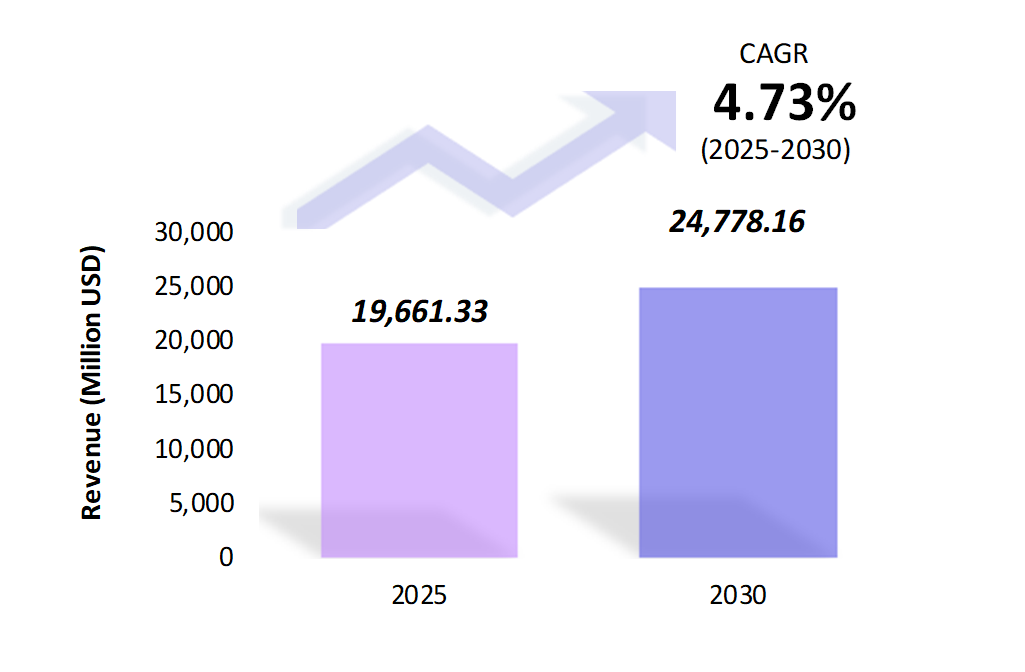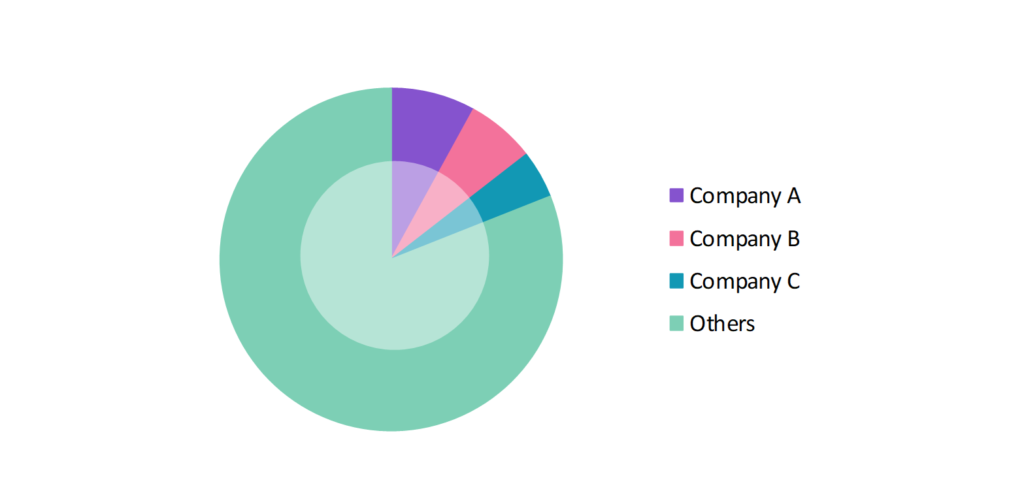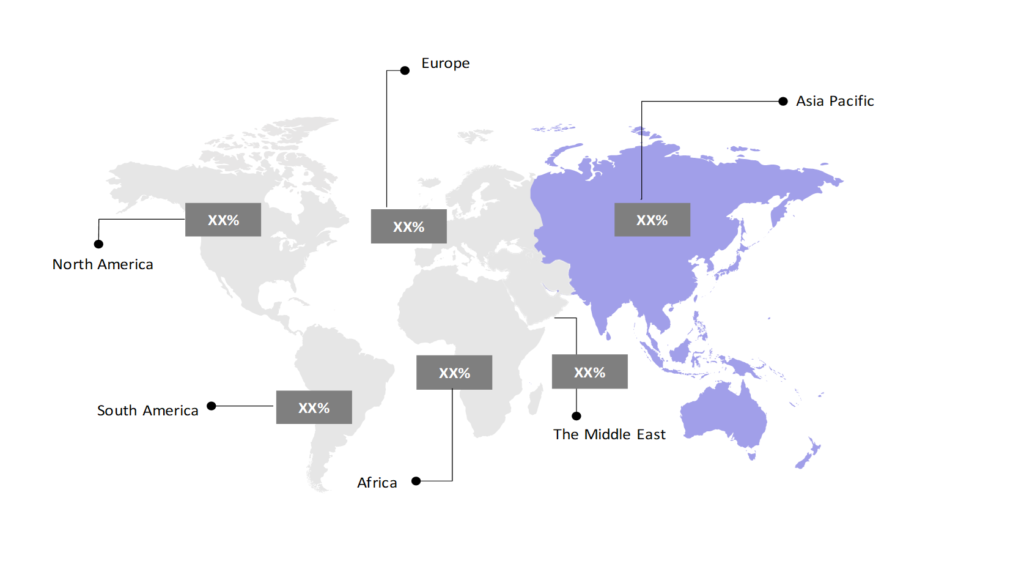Natural Rubber Market Analysis: Growth, Size, Share & Future Trends (2024-2029)
The market report offers a detailed analysis segmented by Type (RSS Grade, Latex Concentrate, Solid Block Rubber, Others); by Application (Auto-Tire Sector, Gloves, Footwear, Latex Products, Others); by Geography (North America, South America, Asia Pacific, Europe, The Middle East, Africa).
Outlook

- The natural rubber market is estimated to be at USD 19,661.33 Mn in 2025 and is anticipated to reach USD 24,778.16 Mn in 2030.
- The natural rubber market is registering a CAGR of 4.73% during the forecast period 2025-2030.
- Natural rubber, extracted from rubber trees, is essential for various industries, particularly automotive tire production, footwear, and medical devices. The market for natural rubber is influenced by the global automotive industry, the availability of synthetic rubber alternatives, environmental concerns, and supply chain dynamics.
Request a free sample.
Ecosystem

- The participants in the global natural rubber industry are leading the charge in producing and sourcing natural rubber for various industries, including automotive, healthcare, and manufacturing.
- These companies focus on technological innovation in processing technologies, along with mergers and acquisitions to expand their product portfolio and maintain a competitive edge in the market.
- Several important entities in the natural rubber market include Sri Trang Agro-Industry Public Co., Ltd.; Thai Hua Public Co., Ltd.; Halcyon Agri Corp., Ltd.; Num Rubber & Latex Co., Ltd.; Von Bundit Co., Ltd.; and others.
Ask for customization.
Findings
| Attributes | Values |
|---|---|
| Historical Period | 2019-2023 |
| Base Year | 2024 |
| Forecast Period | 2025-2030 |
| Market Size (2025) | USD 19,661.33 Mn |
| Market Size (2030) | USD 24,778.16 Mn |
| Growth Rate | 4.73% CAGR from 2025 to 2030 |
| Key Segments | Type (RSS Grade, Latex Concentrate, Solid Block Rubber, Others); Application (Auto-Tire Sector, Gloves, Footwear, Latex Products, Others); Geography (North America, South America, Asia Pacific, Europe, The Middle East, Africa) |
| Key Vendors | Sri Trang Agro-Industry Public Co., Ltd.; Thai Hua Public Co., Ltd.; Halcyon Agri Corp., Ltd.; Num Rubber & Latex Co., Ltd.; Von Bundit Co., Ltd. |
| Key Countries | The US; Canada; Mexico; Brazil; Argentina; Chile; China; India; Thailand; Malaysia; Spain; Germany; Poland; UK; Turkey; UAE; Israel; Egypt; South Africa |
| Largest Market | Asia Pacific |
Get a free quote.
Trends
- Sustainable Rubber Sourcing Initiatives: Companies are focusing on sustainably sourced rubber to reduce environmental damage caused by deforestation and the overexploitation of rubber plantations. Sustainable certification programs like the Forest Stewardship Council (FSC) and the Global Platform for Sustainable Natural Rubber (GPSNR) are growing in prominence. For instance, in 2023, Michelin increased its investments in eco-friendly rubber farming, promoting sustainable agricultural practices for rubber plantations.
- Shift to Agroforestry Practices: Agroforestry, the practice of integrating rubber trees with other crops or native species, is gaining traction in rubber-producing countries. This method aims to diversify income sources for farmers and reduce the negative environmental impacts associated with monoculture rubber plantations.
- Use of Digital Technologies in Rubber Plantations: Digital tools such as the Internet of Things (IoT) and data analytics are being adopted in rubber plantations for optimized yield and resource use. By monitoring soil health, moisture levels, and growth patterns, these technologies enhance plantation efficiency.
Speak to analyst.
Catalysts
- Rising Demand for Disposable Medical Products: The healthcare sector’s demand for latex-based products, including gloves, catheters, and tubing, is increasing as hygiene standards rise globally. This trend was accelerated by the COVID-19 pandemic, which highlighted the need for disposable medical products.
- Supportive Government Policies: Governments in leading rubber-producing nations are implementing policies to boost rubber production, supporting the income of local farmers, and ensuring a steady supply to meet growing global demand. These include incentives for plantation expansion and support for sustainable practices.
- Rising Demand for Eco-Friendly Materials: Natural rubber is a biodegradable alternative to synthetic rubber, aligning with the shift towards environmentally friendly materials. This demand for sustainable products is driving increased adoption of natural rubber in various consumer goods. In 2023, Adidas launched a line of eco-friendly shoes using natural rubber, addressing growing consumer interest in sustainable products.
Inquire before buying.
Restraints
- Fluctuating Rubber Prices: Natural rubber prices are highly volatile due to seasonal production patterns, geopolitical factors, and global economic conditions. Price instability impacts both producers and end-users, complicating supply chain planning and budgeting. In 2022, natural rubber prices surged by 20% due to reduced yields from extreme weather in Southeast Asia, creating cost challenges for manufacturers.
- Stringent Environmental Regulations: Natural rubber production can lead to deforestation and biodiversity loss, drawing scrutiny from environmental agencies and leading to stricter regulations. Compliance with these regulations increases operational costs for producers.
- Impact of Climate Change on Rubber Tree Cultivation: Climate change poses a significant threat to rubber tree plantations, affecting yield and latex production. Extreme weather events, such as droughts and floods, can disrupt the delicate growing conditions necessary for rubber trees, leading to production shortages. In 2023, the Rubber Research Institute of Malaysia highlighted concerns about erratic weather patterns impacting rubber production, leading to lower yields.
Personalize this research.
Hotspot

Explore purchase options.
Table of Contents
| 1. Introduction 1.1. Research Methodology 1.2. Scope of the Study 2. Market Overview / Executive Summary 2.1. Global Natural Rubber Market (2019 – 2023) 2.2. Global Natural Rubber Market (2024 – 2030) 3. Market Segmentation 3.1. Global Natural Rubber Market by Type 3.1.1. RSS Grade 3.1.2. Latex Concentrate 3.1.3. Solid Block Rubber 3.1.4. Others 3.2. Global Natural Rubber Market by Application 3.2.1. Auto-Tire Sector 3.2.2. Gloves 3.2.3. Footwear 3.2.4. Latex Products 3.2.5. Others 4. Regional Segmentation 4.1. North America 4.1.1. The US 4.1.2. Canada 4.1.3. Mexico 4.2. South America 4.2.1. Brazil 4.2.2. Argentina 4.2.3. Chile 4.2.4. Rest of South America 4.3. Asia Pacific 4.3.1. China 4.3.2. India 4.3.3. Thailand 4.3.4. Malaysia 4.3.5. Rest of Asia Pacific 4.4. Europe 4.4.1. Spain 4.4.2. Germany 4.4.3. Poland 4.4.4. UK 4.4.5. Rest of Europe 4.5. The Middle East 4.5.1. Turkey 4.5.2. UAE 4.5.3. Israel 4.5.4. Rest of the Middle East 4.6. Africa 4.6.1. Egypt 4.6.2. South Africa 4.6.3. Rest of Africa 5. Value Chain Analysis of the Global Natural Rubber Market 6. Porter Five Forces Analysis 6.1. Threats of New Entrants 6.2. Threats of Substitutes 6.3. Bargaining Power of Buyers 6.4. Bargaining Power of Suppliers 6.5. Competition in the Industry 7. Trends, Drivers and Challenges Analysis 7.1. Market Trends 7.1.1. Market Trend 1 7.1.2. Market Trend 2 7.1.3. Market Trend 3 7.2. Market Drivers 7.2.1. Market Driver 1 7.2.2. Market Driver 2 7.2.3. Market Driver 3 7.3. Market Challenges 7.3.1. Market Challenge 1 7.3.2. Market Challenge 2 7.3.3. Market Challenge 3 8. Opportunities Analysis 8.1. Market Opportunity 1 8.2. Market Opportunity 2 8.3. Market Opportunity 3 9. Competitive Landscape 9.1. Sri Trang Agro-Industry Public Co., Ltd. 9.2. Thai Hua Public Co., Ltd. 9.3. Halcyon Agri Corp., Ltd. 9.4. Num Rubber & Latex Co., Ltd. 9.5. Von Bundit Co., Ltd. 9.6. Company 6 9.7. Company 7 9.8. Company 8 9.9. Company 9 9.10. Company 10 |
Know the research methodology.
Natural Rubber Market – FAQs
1. What is the current size of the natural rubber market?
Ans. In 2025, the natural rubber market size is USD 19,661.33 Mn.
2. Who are the major vendors in the natural rubber market?
Ans. The major vendors in the natural rubber market are Sri Trang Agro-Industry Public Co., Ltd.; Thai Hua Public Co., Ltd.; Halcyon Agri Corp., Ltd.; Num Rubber & Latex Co., Ltd.; Von Bundit Co., Ltd.
3. Which segments are covered under the natural rubber market segments analysis?
Ans. The natural rubber market report offers in-depth insights into Type, Application, and Geography.
